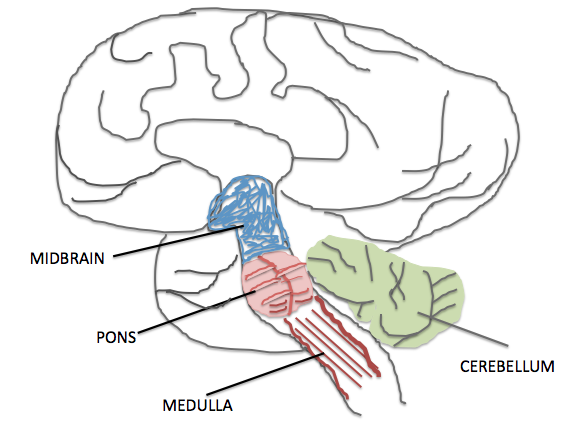The earlier, more basic parts of brain development occurred in the hindbrain. These are the structures of the brain that are at the center or core of the brain and are connected to the spinal cord that goes out to the rest of the body.
This is also an area known as the brainstem, which includes the midbrain as well as the hindbrain.

The first section of the brainstem is the medulla, or the full name, medulla oblongata. It is connected directly to the spinal cord.
The medulla oblongata is related to involuntary body processes--those functions that are important in keeping us alive. The medulla regulates functions like breathing, heart rate, digestion, and swallowing. You may think of them as reflexes, but they are not; a lot of reflexes are controlled by the spinal cord itself.
The pons is located directly above the medulla and literally means "bridge" in Latin. You can see why, because the pons is related to transferring information from the hindbrain to the other areas of the brain.
The pons transfers information between the medulla and the brain, as well as the rest of the brain structures, particularly in relation to things like sleep and arousal. It's kind of a messenger that also helps to regulate those types of important bodily processes, and this works in conjunction with the reticular formation, covered in the next section.
The reticular formation (RF) is a little network of neurons, located inside the medulla and up to the pons. It is associated with attention and alertness. It's also related to functions like sleep and arousal, like the pons. The reticular activating system (RAS), activates other areas of the cerebral cortex, and is the system that keeps you awake or alert.
EXAMPLE
The RAS ensures that you are awake during certain periods of time, like when you're trying to study for a test late at night.The cerebellum is a cauliflower-looking structure located at the rear of the brain, right underneath and in the back of the cerebral cortex and all the other structures.
The cerebellum controls movements and helps to regulate coordination and balance. Again, this is a very important basic area of the brain. It keeps you upright and keeps you moving. It's also related to memories of skills and habits, meaning those kinds of things that involve motor movements and basic sorts of memory, that you don't necessarily have to think too hard about.
Source: This work is adapted from Sophia author Erick Taggart.